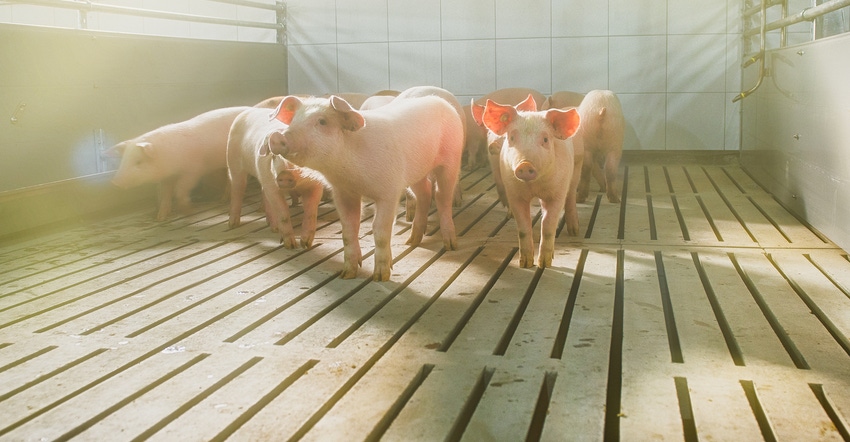February 4, 2020

Ohio is home to 2.7 million hogs, that statistic is as of December 2016. The new Clemens Food Group processing plant in Coldwater, Mich., has created an opportunity for swine expansion in the state of Ohio.
The areas for expansion in Ohio that fit well are the northwest and north-central parts of the state, for both the land base and the minimal number of livestock operations there. West-central Ohio is home to the No. 1 and No. 2 swine-producing counties in the state. Thus, expansion efforts in this part of the state have been at a crawl due to the abundance of swine producers already established.
Construction of swine finish units has occurred in the past couple years, and construction will continue to meet capacity at the new Clemens Food Group processing plant. Since it is already known that expansion is occurring in northwest Ohio (and northeast Indiana), what are some guidelines to look for or questions to answer for producers looking to get in on these expansion efforts?
First, a producer must look at the Ohio Department of Agriculture site criteria, even if the facility does not need to be permitted. A facility that requires a permit is one that houses more than 2,500 head of swine weighing more than 55 pounds. By following ODA criteria, producers can assure themselves that a facility will be in an area of minimal nuisance to neighbors and waters of the state. Using an example of a producer wanting to construct a single double-wide unit (2,400 head), the following are some of the ODA siting criteria that should be followed:
• 1,000 feet from residence
• 100 feet from property lines
• 50 feet from wells
• 300 feet from waters of the state
• 15 feet of low-permeable material below the bottom of the pit structure, or water-tight with monitoring requirements (information derived from soil borings and any associated subsurface geological reports)
Engineered drawings and site layout
The second item to consider is the volume of manure to be generated and the nutrient content of the manure. On average, a single double-wide unit can generate 700,000 gallons of liquid manure. Since phosphorus has been discussed, researched and scrutinized over the past several years regarding water quality, understanding the phosphorus content of the manure is crucial. I will use 25 pounds of phosphate (P2O5) per 1,000 gallons for my example, and I will use this number for the calculations and discussion to follow. Using the ratio of 25 pounds per 1,000 gallons P2O5, a single double-wide unit would generate 17,500 pounds of phosphate.
Next, a producer will need to look at the land base surrounding a potential facility site location to determine the number of acres that will be accessible for manure application. Soil test results are of upmost importance to this determination. ODA and the Natural Resources Conservation Service have similar rules and guidelines, respectively, for manure application in relation to soil-test phosphorus (STP) levels. The following are those rules and guidelines:
• < 40 parts per million STP (Mehlich III or Bray PI), maximum 250 pounds P2O5
• 40 to 100 ppm STP (Mehlich III or Bray PI), multiyear crop phosphorus removal
• 100 to 150 ppm STP, single-year crop phosphorus removal
• >150 ppm STP, no manure
How many acres needed?
The question becomes, how many acres would a producer need for a single, double-wide unit? Let’s do the math. By knowing the gallons and pounds of phosphate a barn would generate along with average crop yields for the area and the typical crop rotations used, we can determine the acreage requirement for varying soil-test phosphorus levels. I will use a corn-soybean-wheat rotation with yields at 180, 60 and 85 bushels per acre, respectively.
For STP below 40 ppm, a producer could apply 10,000 gallons of manure per acre annually (if that rate does not exceed the intended crop’s nitrogen needs) and could do so on 70 acres. To determine the maximum rate that can be applied, divide the total maximum pounds per acre of phosphate that can be applied by the phosphate in the manure (250/25). Then, divide the total gallons generated by the application rate (700,000/10,000).
For STP 40 to 100 ppm, a producer could apply 6,760 gallons per acre (if that rate does not exceed the intended crop’s nitrogen needs) and could do so on 104 acres annually. However, since the application rate is based on multiyear crop phosphorus removal (169 pounds per acre of P2O5) , the producer will need access to a minimum of 312 acres (104 acres in a three-year crop rotation).
For STP 100 to 150 ppm, a producer could apply only 2,250 gallons per acre. This rate typically will not exceed the nitrogen needs of the intended crop. Based on the three-year crop rotation example, about 56 pounds per acre of P2O5 shall be removed on average annually. The producer will need access to a minimum of 311 acres annually. However, this rate could be applied to those same acres every year, since the rate was determined based on crop removal only.
Ownership of the required acres is not necessary — although, at a minimum, a manure land use agreement should be in place between the swine producer and farm owner to outline responsibilities of each party.
The state of the pork industry in the state of Ohio is alive and in expansion mode. With that comes the need for proper siting and manure management, so the rural communities of northwest Ohio — and beyond — can continue to flourish without concerns for water quality, and, ultimately, their daily lives.
Otte is a certified crop adviser and consultant, and the owner and president of Otte AG LLC.
You May Also Like




